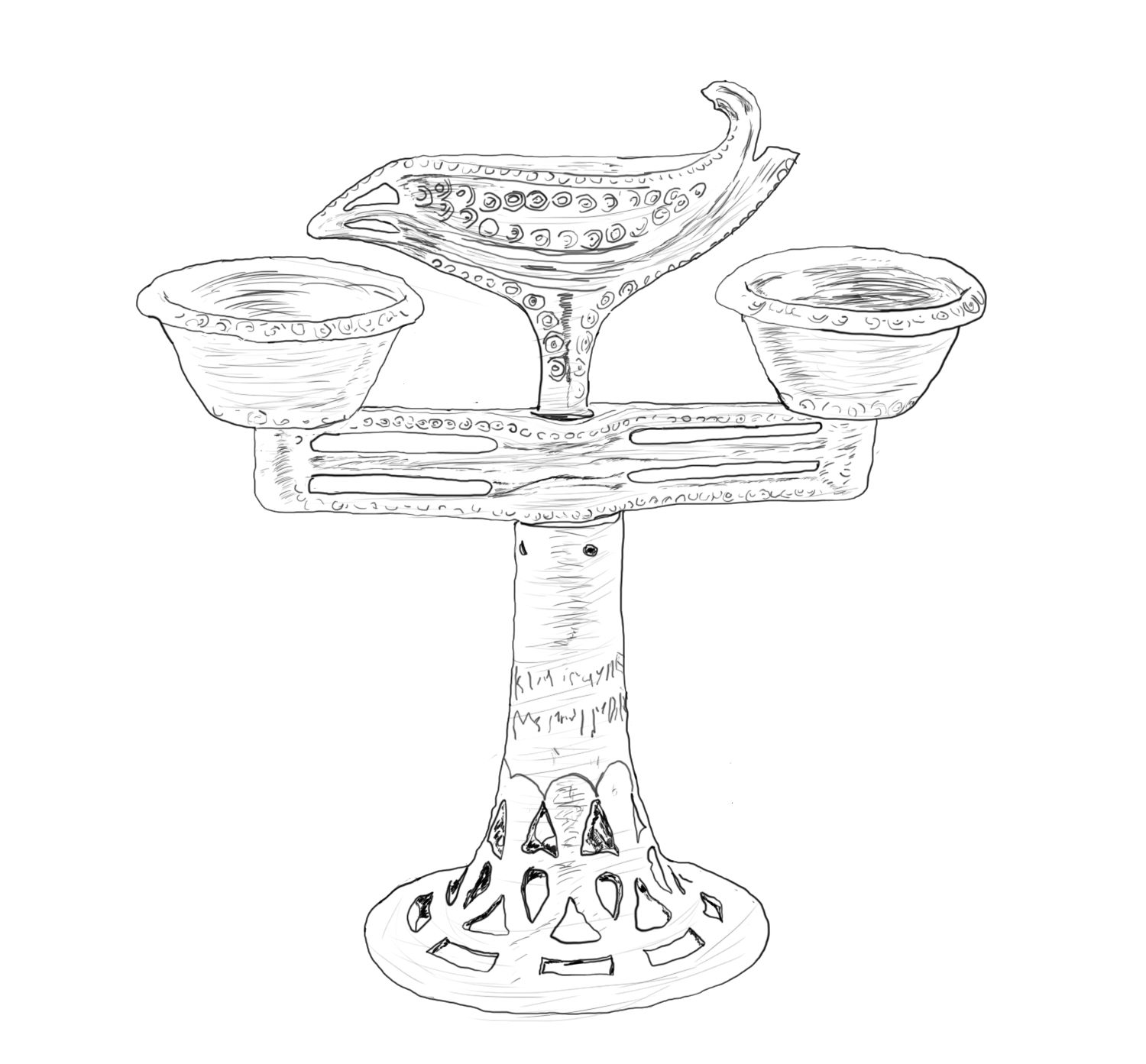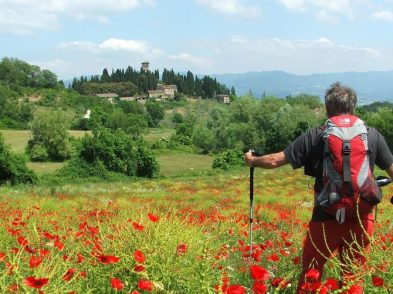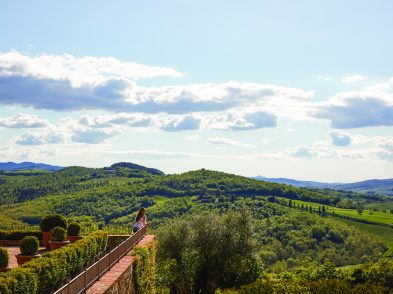Did you know that an opportunity to explore the world of the Etruscan warrior princes who dominated Tuscany 3,000 years ago is within a drive of Florence? All part of the Parco Archeologico Carmignano, the fascinating Comeana necropolis, the Artimino archaeological site and museum, and the Pietramarina archaeological site are not only close by but free (or nearly so). Your inner Indiana Jones is eager for adventure, so take along our handy glossary, check out food and lodging options here and make a date with the past.
Drawing of the Bucchero Censer by Michele Giugni
Visit 1. Comeana necropolis
This site houses the Boschetti and Montefortini tumuli. The Boschetti tumulus, dating from the first half of the seventh century BCE, has a slab-wall funerary cell probably used for two cremation burials.
The Montefortini tholos tomb, an imposing tumulus 12 metres high with a diameter of 60 metres, encircled by sandstone blocks and linked to a terrace-altar used for the funerary ceremonies, dates from the middle of the seventh century BCE and holds two tombs. The older, in the centre, consists of a long dromos and a magnificent tholos of more than 7 metres in diameter, with a central pillar, and has yielded extraordinary finds, among them a rare turquoise glass bowl, wonderful bucchero fretworked censers and more than 200 carved ivory objects with figures of men and women, animals (both real and imaginary) and floral elements, all on display at the Artimino Archaeological Museum. Dating between the last 20 years of the seventh and the beginning of sixth century BCE, these burial objects, including an Egyptian New Year’s flask, reveal the deep economic and political relationships between the great Artimino Etruscan families and the Eastern Mediterranean trading hubs.
A few years after its construction, the first tholos collapsed, probably in a strong earthquake. Then a rectangular chamber tomb was built under the artificial hill, with an open dromos and a trilithon portal opening to a quadrangular vestibule and then to the cell with a fantastic slab ceiling.
Getting there. From Florence, take SS 66 to Poggio a Caiano, where it branches off for Comeana and Artimino. The Boschetti tumulus is before Comeana, near the present-day cemetery (via Lombarda, Comeana, 59015 Carmignano) and is always visible from the fence. Continue on the same road to Comeana to the Montefortini tumulus (via Montefortini, Comeana). Monday–Saturday, 9 am–2 pm, free, with free guided tours the first Saturday of every month at 9.30am.
While you’re in the area. Poggio a Caiano is home to the splendid villa of Lorenzo the Magnificent, built 1484–1520.
Visit 2. Artimino archaeological site
Give yourself plenty of time to explore the Prato Rosello necropolis and the Francesco Nicosia Artimino Archaeology Museum. The Prato Rosello Etruscan necropolis (late eighth to sixth century BCE) features a series of tumuli. Among these are Tumulus B, the warrior-prince’s tomb reconstructed in the museum, and Tumulus C, the source of the beautiful bucchero censer, also displayed in the museum. (Entrance is free, as is a tour the first Saturday of every month (weather permitting) except August; meet at 9:30 am at the Montefortini tumulus in Comeana.)
The museum displays a trove of noteworthy findings, such as those from the Comeana necropolis. Items from ‘the world of the living’ include ollae and dolia from the fortified settlement of Pietramarina and spindles and loom weights from Pietramarina and the Field of Pheasant settlements, suggesting that weaving was an important daily activity of Etruscan women.
Items from ‘the world of the dead’ bring you into the late eighth-century/early seventh-century BCE period of the proud Etruscan warrior-prince interred in the Prato Rosello necropolis. You can admire a bronze kardiophylax; a blade of a lance made of ash, the wood associated with Homeric heroes; a dagger and sheath; and a bronze vase containing pine resin, pollen and beeswax. The extraordinary bucchero censer from tumulus C bears an inscription in the northern Etruscan language, thought to be dedicated to a child. In addition to a number of pear-shaped aryballoi and ring-shaped askòi, there is a 41-centimetre ceremonial iron knife from the Prato Rosello tumulus X.
The sandstone effigies of the Etruscan warrior-princes on tombstones from sixth to third centuries BCE attest to the richness of these aristocrats. The huge fourth-century BCE red krater from the Grumaggio necropolis showing figures in a Dionysian procession was originally designed for the preparation of wine and then used as a burial urn. Companion to a rich service of elegant bronze vases and attributed to the Clusium-Volaterrae group, the krater shows the continuity of relationships between Artimino and Volterra from the eighth century BCE onward.
Getting there. To get to the Prato Rosello necropolis, follow the road leading to Poggio alla Malva and take the path that branches off to the left at the yellow sign to Artimino and Prato Rosello. Artimino Archaeology Museum is located in piazza San Carlo, 3, Artimino (Carmignano). Thursday to Tuesday, 9.30am–1.30pm; and additionally 3–6pm on Saturday, Sunday and holidays. 4 or 2 euro.
While you’re there. On the road to Artimino, see the beautiful Medici Villa ‘La Ferdinanda,’ also known as ‘The Hundred Chimneys Villa.’ Now a resort hotel, it was built at the end of the 16th century on the site of the Etruscan settlement by the architect Bernardo Buontalenti. In Artimino, see the Pieve di San Leonardo, a church built in the second half of the 10th century.
Visit 3. Pietramarina archaeological site
What you’ll see. Located on top of the southern offshoot of Montalbano, 585 metres above sea level, in a strategic position to control a vast territory and the roads linking northern, central and southern Etruria, Pietramarina was probably a long-occupied fortified sanctuary, at least from seventh to the first century BCE. Especially impressive is the 2.9-metre thick stone wall, extending for 360 metres. The area inside the wall includes several buildings, only partially excavated to date. This site is also the source of three large jars now on display at Artimino Archaeological Museum, which were found in a building destroyed by a fire.
Getting there. From Carmignano take the Vergheretana road to San Giusto. Park near the restaurant Il Pinone and walk the path leading to the excavation area of Pietramarina. Walking the excavations, which are open May to November, involves an easy 30-minute route.
While you’re in the area. Carmignano’s parish church of San Michele houses Pontormo’s beautiful Visitazione (1529).
Glossary
Aryballos (pl. aryballoi): Small spherical bottle used for oil or perfume.
Askòs (pl. askòi): Small flat bottle used for oil or perfume.
Bucchero: Fine black Etruscan pottery made with a special firing technique.
Censer: Vessel for burning incense.
Dolium (pl. dolia): Large jars used for grain or wine.
Dromos: Open in-ground corridor leading to a burial.
Kardiophylax: Breastplate.
Krater: A large, round, wide-mouthed jar used for mixing water and wine.
Olla (pl. ollae): Pot with flanged rim, used for cooking and preserving food.
Tholos: Dome-shaped tomb.
Trilithon: Two vertical stones supporting a horizontal third stone.
Tumulus (pl.tumuli): Mounded grave site.





